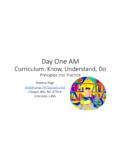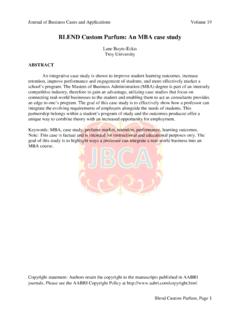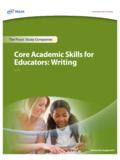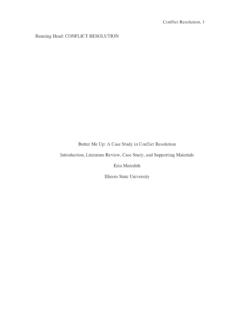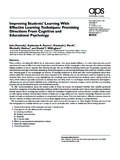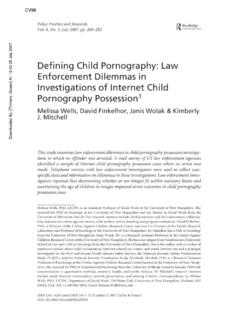Transcription of Look-Fors in an Effectively Differentiated Classroom
1 1 Look-Fors in an Effectively Differentiated Classroom This instrument was developed by Carol Ann Tomlinson & Jessica Hockett for Learning Sciences International. For permission to duplicate, please contact Background (No teacher should be expected to display all these attributes at a given time. Rather these are elements toward which strong teachers persistently work and many of which strong teachers regularly demonstrate in their teaching. Guiding questions in this document are useful in conversations with teachers as catalysts for further thinking.) Differentiated Instruction is a proactively planned, interdependent system marked by a positive community of learners; focused, high-quality curriculum; frequent formative assessment; flexible instructional arrangements; and respectful tasks.
2 Student needs are the motivation for Differentiated instruction. Building a sense community among students and the teacher in a positive learning environment is the foundation for Differentiated instruction. Focused, high-quality provides the compass for Differentiated instruction. (High-quality differentiation is necessary for high-quality differentiation.) Frequent formative assessment is the primary tool for gathering information about how and why to differentiate instruction. Well-managed, flexible grouping provides a mechanism for Differentiated instruction. A variety of low-prep and high-prep strategies can be used to design and deliver respectful tasks that adjust content, process, and products for students readiness, interests, and learning profiles.
3 CATEGORIES, Look-Fors , RUBRICS & GUIDING QUESTIONS Look for 1: Classroom Environment Category: The teacher builds a foundation for Differentiated instructed on a solid Classroom community and a positive learning environment. Indicators: The physical and affective characteristics of the Classroom set a positive tone for learning. 2 The teacher fosters respect for individual differences and preferences. The teacher and students share ownership of and responsibility for the Classroom . Evidence: The teacher communicates explicitly and implicitly to students that they are multi-faceted individuals whose needs, preferences, and strengths are dynamic. The teacher communicates implicitly and explicitly to students that they and their contributions are valuable and necessary in order for the Classroom to function well.
4 The teacher helps students get to know one another well. The teacher encourages creativity of thought and expression. The teacher structures activities so that students see one another in varied contexts and in varied roles. The teacher assists students in setting their own personal and class goals for learning and behavior. The teacher solicits student input in making decisions that will affect the whole class. The teacher frequently asks students for feedback on how the class is working for them, and for suggestions about how they and the teacher could work together toward improvement. The teacher designs and assigns roles for students to assume in making the routines and systems flow smoothly.
5 Rubric: Classroom Environment Advanced 4 a. The affective and physical attributes of the Classroom environment inspire students to achieve their personal best and to take initiative in learning. b. The teacher empowers students to view their and each other s differences as assets to the Classroom community such that students view one another as equals. c. The teacher and students are equal partners in sharing responsibility for the Classroom . Proficient 3 a. The affective and physical attributes of the Classroom environment equip students to succeed in achieving the teacher s high expectations. b. The teacher honors student differences, nurtures student strengths and preferences, and provides opportunities for students to compensate for their weaknesses.
6 C. The teacher shares his/her roles and responsibilities with students, allowing them to control many aspects of Classroom routines Basic 2 a. The affective and physical attributes of the Classroom environment convey ambiguous messages about how the teacher views the student s role in the learning process. b. The teacher recognizes student differences, but does not build on them to foster a positive Classroom environment. 3 c. The teacher allows students to share some of his/her roles and responsibilities. Below Basic 1 a. The affective and physical attributes of the Classroom environment alienate students and quench their desire to learn. b. The teacher ignores or is hostile toward student differences.
7 C. The teacher does not share any of his/her roles and responsibilities with students. Classroom Community Advanced 4 Compare the way your current Classroom looks and feels with how it looked and felt in your first year of teaching. How do you encourage students to apply and transfer what they learn in your Classroom about student differences to the real world? What would it look like to allow students to have even more control over the Classroom ? Proficient 3 How do student differences impact your decisions about the physical aspects of your Classroom ( , how the room is set-up, the messages students see on the walls)? How do you capitalize on the strengths and maturity level of this age group to help daily routines run more smoothly?
8 Basic 2 How do you help students see one another as equally valuable to the Classroom community? In what ways do you communicate to students that this is their Classroom ? How do you decide which Classroom roles responsibilities to give to students, and which to keep in your control? Below Basic 1 What are some ways that students in your class differ from one another, and from you? What are some concrete ways you communicate to them that those differences are assets to the Classroom community? What are the most flexible aspects of your physical Classroom space? Look for 2: Curriculum Category: The teacher uses high-quality, coherent curriculum as a compass for Differentiated instruction.
9 Indicators: The teacher plans curriculum so that important conceptual ideas are at the forefront of a unit of study. Essential facts and skills are used to help students make sense of these ideas. The teacher uses the curriculum as a point of engagement, of motivation, and of access to powerful ideas. The teacher ensures that the curriculum is an authentic reflection of the discipline being studied. Evidence: The teacher frames learning goals in terms of what students should know, understand, and be able to do as a result of the lesson/unit. 4 The teacher clearly communicates the learning goals to students. The teacher connects the knowledge and skills students are learning to an essential question, big idea, important principle, and/or overarching concept.
10 The teacher connects the curriculum to students collective and individual experiences and interests. The teacher engages students in activities that help them see how what they are learning is used in the real world ( , by real historians, scientists) Rubric: Curriculum Advanced 4 a. The curriculum is a conduit for developing expertise. b. The teacher plans a curriculum focused on what students should know, understand, and be able to do and which facilitates in-depth perspective. c. The teacher uses the curriculum in ways that inspire students to ask high-level questions, pursue further information on their own, and make their own suggestions for class activities. d. The teacher fosters relevance helping students transfer and connect important ideas/concepts to familiar and unfamiliar contexts.
